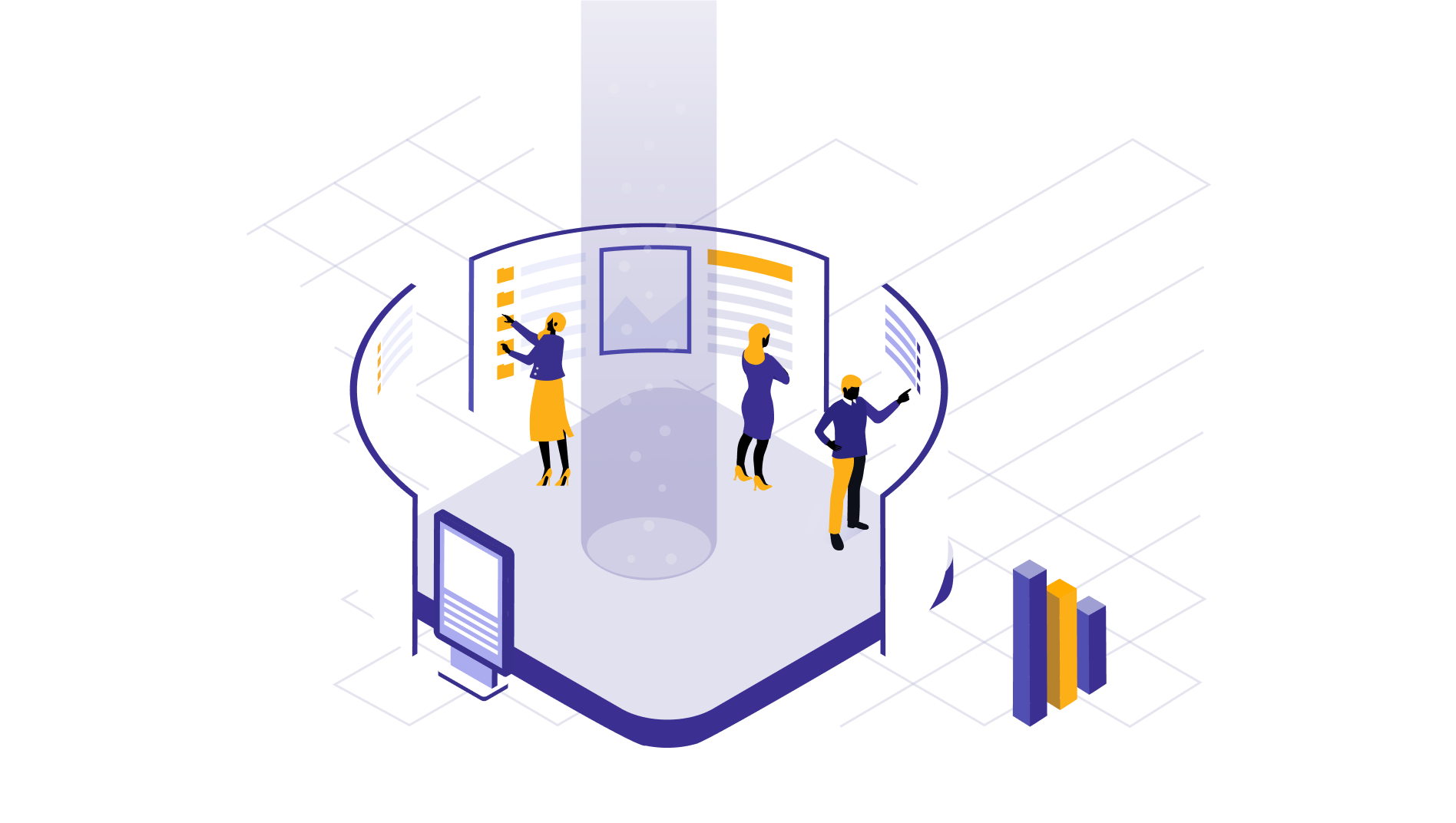Customer 360: Complete view of your customers
How does having a 360-degree view of your customers help? How can businesses enable customer 360 solutions to elevate their marketing, sales, and other business processes? Read the entire blog to know the importance and applications of Customer 360.

Jagadeesan
April 6, 2024 |
5 mins

What is Customer 360?
Customer 360 is a centralized solution that maps every point of your customer journey together in one place. It’s a storage repository for all your customer-related information - their personal details, purchase history, interactions with sales or customer support teams, social media interactions, and everything like that.
Having all of this in one platform gives you a holistic understanding of your customers and how they engage with your business. This comes in handy in retargeting them with suitable products, increasing their purchase behavior, and developing an overall positive branding experience.
This is reflected by increasing their order and lifetime value and better customer retention.
By setting up customer 360 solutions, you go beyond the regular analytics and have a more detailed view of your customers’ role in your business growth.
How does it work?
Customer 360 works by integrating different platforms and data sources through which your customers interact with you. For example, Salesforce, Google Analytics, Social media statistics, and support ticketing applications. It’s not only meant for tracking online experiences because it can collect offline touchpoints as well, ex. An event, webinar, or conference that customers attended, offline store interactions, purchases, etc.
Imagine this as a single source of truth that maintains one version of your customer data across all levels.
This is how it works. Customer 360 uses ETL data integration to collect data from applications, transform to suitable formats, and load it into Customer 360.
Collects data from respective sources: With the help of APIs and integrators, it collects data from applications that deal with customer data.
Preparation: This data might be in different formats. So, it must be converted into a unified format suitable for analysis and interpretation.
Data storage: All of these real-time and historical data is ingested into a central location, like a data warehouse.
Identity resolution, that is linking and mapping data together that’s about one customer and repeating the same for all: This is where you connect all types of data to understand its underlying relationships with one another.
This is how we integrate and co-relate data stuck in siloed sources to offer a congregated view of your customers.
Recommended read: What is customer sentiment analysis?
Customer 360 challenges
Implementing a customer 360 platform is more complex than one would think, mainly because most companies today run omnichannel experiences. So, there is data coming in from all directions with or without serving actual value.
So, unless you strategize it right, Customer 360 will just become a master data management, acting merely like a storage solution for your customer data.
Following are the other challenges you might face when you begin your customer 360 journey.
Too many applications
Modern organizations have a tool to track everything. An overload of applications means an overload of data. Hence, it might take time for you to figure out what’s needed and what can be discarded or altered.
Too much data can also be an issue as it increases processing time, leading to clunky storage and inaccurate analysis. On top of that, this data keeps changing with new entries replacing the old ones.
Though modern customer 360 applications are adept at handling the magnitude of data and support scaling, they require proper planning and well-thought-out execution.
Data duplication
Duplicate records are the biggest problem many industries are facing which also has an impact on the accuracy of reports. For example, the same customer might be present on different records of the company under different names, like John and Johnson, creating too many identities for the same person and skewing analytics outcomes.
Also, different teams measure the same data under different names. This can also cause duplicated records, increasing the complications further.
Data quality
Inadequate data is also one of the challenges that affect customer 360 implementations. It can be about data tables with missing values, duplicates, hidden or inaccurate entries, inconsistent formatting, and more.
And certain organizations store loads of unstructured data in data lakes which can take months to process, normalize, and make it analytics-friendly.
Data silos
Every department has its own analytics platforms with metrics that matter to them. This causes them to operate in siloes and uniting them to have a centralized view can be a challenge at the start.
While you have tools to integrate the data, you also have to think about the people who use them. This is a whole cultural shift for them. So, you will have to think about transitioning each department to this new process and getting them used to this.
Data privacy
Collecting, storing, and analyzing sensitive data like customer details require a carefully curated strategy. One mistake and the entire data can be at stake, with cybercriminals lurking from all corners. Exposing customer details can work in all negative ways—from customers losing their trust to hampered business reputation—something a business can never recover from. Besides, based on your industry and demography, you will have a few compliance requirements like GDPR to follow.
All of this makes it harder for businesses to protect their customer data and put that to good use while keeping security incidents to zero.
Customer 360 benefits
Despite these challenges, Customer 360 is beneficial in many ways if done correctly. Some of the benefits of having a 360-degree customer view include:
Pays a way for predictive analytics
Predictive analytics is useful for sales and marketing in many ways. Customer 360 gives you a way to handle this as it lets you see both the past and present data of your customers.
For example, you can find out how many prospects will become customers in the next sales cycle. Or, identifying dissatisfied customers and fixing their concerns or targeting them with hyper-personalized strategies.
Your teams can also ask futuristic questions and find answers from their data. Ex. like what features customers are likely to pay for, and more such questions on customer behavior.
This gives you an edge in acting and salvaging damages before they occur with teams working together as one unit.
Want to improve this further? Use reverse ETL to feed back insights from customer 360 into their operational systems, making it more accessible and employable for all. Reverse ETL is the process, which extracts insights from centralized repositories like Customer 360 and sends them back into respective applications. Example: Sales team can see aggregated details about the pipeline performance within their CRM itself.
Learn more: What is reverse ETL?
Unified data and advanced analytics
With Customer 360, not just the data becomes united but the teams that operate on them too. This widens the perspective of departmental leaders and users, allowing them to have a holistic view rather than a siloed view. For example, marketing teams can have a better lead scoring system, being able to see their conversion cycles and purchase patterns. So, they can make data-driven decisions with more precision now with this advanced customer journey mapping.
Reduces operational costs
With more careful and well-planned strategies, your teams can spend money on initiatives that offer more returns. Thus, you could stop wasting money on what doesn’t work and avoid expensive mistakes that usually occur due to hidden views and siloed data.
For example, with a holistic view, you can identify customers who contribute low or no value to the business and stop wasting money or effort on them.
Personalization
One of the successful weapons for modern marketing teams - running personalized campaigns. This cannot be successful unless you figure out who your customers are, their preferences, their purchase patterns, spending capacity, and more.
And how do you find all this data and amass them in one place? - Customer 360 analytics.
A 360-degree view allows you to dissect customers from all angles, form solid opinions, and segment them into categories so you can target each separately.
This personalized experience helps customers feel closer to your brand, improving conversion rates, customer loyalty, and overall campaign success.
Conclusion
We have so moved from times when CRMs were seen as the master data management for customers. All thanks to the multi-channel model of businesses and numerous customer touchpoints. Customer 360 lets you be aware of all these points, tracing them like a journey, and brings you to the question - what next? That is, what will be the next move of the customer?
This futuristic perspective is required to handle modern problems businesses like yours face, catering to customers' expectations, demands, and whims that change every second.
Customer 360 analytics guarantee this.
So, you don’t just deliver elevated customer experiences but personalize them and modify them from time to time.
What about data privacy and security - you may ask. We understand that this is a non-negotiable for your business and offer custom solutions that integrate your data sources and centralize information - all within a secure space.
If you feel like this sounds promising, but get the hint that it’s going to be a rough start, we should talk. We have recently helped one of the fast-growing businesses set up Customer 360 so they can see beyond their basic, partial-viewed analytics platform. Spend a minute and send us your requirements below so we can get your customer 360 plans off the ground.

by Jagadeesan
“datakulture’s co-founder, thought leader, and skilled team leader, Jagadeesan has worked with companies across industries and geographies. He knows how data problems hide in plain sight—whether in manufacturing floors, retail shelves, or financial dashboards—and how the right strategy can turn them into opportunities. With years of experience guiding teams and clients alike, he ensures data solutions don’t just look good on paper but deliver measurable business impact.



